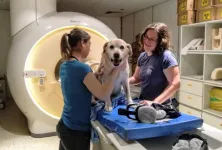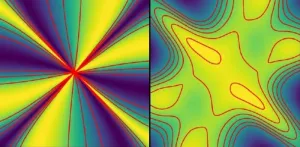(Press-News.org) Solvated dielectrons are the subject of many hypotheses among scientists, but have never been directly observed. They are described as a pair of electrons that is dissolved in liquids such as water or liquid ammonia. To make space for the electrons a cavity forms in the liquid, which the two electrons occupy. An international research team around Dr. Sebastian Hartweg, initially at Synchrotron SOLEIL (France), now at the Institute of Physics at the University of Freiburg and Prof. Dr. Ruth Signorell from ETH Zurich, including scientists from the synchrotron SOLEIL and Auburn University (US) has now succeeded in discovering a formation and decay process of the solvated dielectron. In experiments at the synchrotron SOLEIL (DESIRS beamline), the consortium found direct evidence supported by quantum chemical calculations for the formation of these electron pairs by excitation with ultraviolet light in tiny ammonia droplets containing a single sodium atom. The results were recently published in the scientific journal Science.
Traces of an unusual process
When dielectrons are formed by excitation with ultraviolet light in tiny ammonia droplets containing a sodium atom, they leave traces in an unusual process that scientists have now been able to observe for the first time. In this process, one of the two electrons migrates to the neighbouring solvent molecules, while at the same time the other electron is ejected. “The surprising thing about this is that similar processes have previously been observed mainly at much higher excitation energies,” says Hartweg. The team focused on this second electron because there could be interesting applications for it. On the one hand, the ejected electron is produced with very low kinetic energy, so it moves very slowly. On the other hand, this energy can be controlled by the irradiated UV light, which starts the whole process. Solvated dielectrons could thus serve as a good source of low-energy electrons.
Generated specifically with variable energy
Such slow electrons can set a wide variety of chemical processes in motion. For example, they play a role in the cascade of processes that lead to radiation damage in biological tissue. They are also important in synthetic chemistry, where they serve as effective reducing agents. By being able to selectively generate slow electrons with variable energy, the mechanisms of such chemical processes can be studied in more detail in the future. In addition, the energy made available to the electrons in a controlled manner might also be used to increase the effectiveness of reduction reactions. “These are interesting prospects for possible applications in the future,” says Hartweg. “Our work provides the basis for this and helps to understand these exotic and still enigmatic solvated dielectrons a little better.”
Overview of facts:
Original publication: S. Hartweg, J. Barnes, B. L. Yoder, G. A. Garcia, L. Nahon, E. Miliordos, R. Signorell: Solvated dielectrons from optical excitation: An effective source of low-energy electrons, Science 0, eadh0184. DOI: https://doi.org/10.1126/science.adh0184
Dr. Sebastian Hartweg is a research associate at the Institute of Physics at the University of Freiburg. His research interests include studies of the electronic structure and dynamics of molecules and molecular clusters. Prof. Dr. Ruth Signorell heads the Aerosols and Nanoscience research group at ETH Zurich. In addition to the University of Freiburg and ETH Zurich, the synchrotron SOLEIL in Saint-Aubin, France and Auburn University in the US were involved in the research.
The project was supported by the European Union's Horizon 2020 research and innovation programme of the European Research Council under grant agreement 786636, the Swiss National Science Foundation (project 200020_200306), and the United States National Science Foundation (Grant No. CHE-1940456).
Contact:
Office of University and Science Communications
University of Freiburg
Tel.: 0761/203-4302
email: kommunikation@zv.uni-freiburg.de
END
Emergence of solvated dielectrons observed for the first time
2023-05-26
ELSE PRESS RELEASES FROM THIS DATE:
Networks in the dog brain
2023-05-26
A study on canine brain networks reveals that during mammalian brain evolution, the role of the cingulate cortex, a bilateral structure located deep in the cerebral cortex, was partly taken over by the lateral frontal lobes, which control problem-solving, task-switching, and goal-directed behavior. The study relies on a new canine resting state fMRI brain atlas, which can aid in the analysis of diseases characterized by dysfunctional integration and communication among brain areas.
Researchers interested in how dogs think can not only deduce it from their behavior, but they can also investigate their brain activity using fMRI (functional ...
Fractons as information storage: Not yet quite tangible, but close
2023-05-26
Excitations in solids can also be represented mathematically as quasiparticles; for example, lattice vibrations that increase with temperature can be well described as phonons. Mathematically, also quasiparticles can be described that have never been observed in a material before. If such "theoretical" quasiparticles have interesting talents, then it is worth taking a closer look. Take fractons, for example.
Perfect storage of information
Fractons are fractions of spin excitations and are not allowed to possess kinetic energy. As a consequence, they are completely stationary and immobile. This makes fractons new candidates for perfectly secure information storage. Especially since ...
Defence lawyers face challenges accessing and reviewing digital evidence, study shows
2023-05-26
Defence lawyers face numerous challenges accessing and reviewing evidence from phones and computers, a new study shows.
Solicitors and barristers have reported their use of digital evidence can be restricted by limited or late access, large volumes of material, and tight turnaround times to secure legal aid funding and choose and instruct independent experts.
The research calls for more clarity and transparency around the collection and analysis of digital evidence and the streamlining of the format and presentation of information.
The current volume and diversity of digital evidence available escalates tensions, delays access to digital ...
Barren habitat for sows leaves imprint on piglets’ brains
2023-05-26
In a new study, researchers from Uppsala University in Sweden, together with colleagues from the University of São Paulo, Brazil, have investigated the impact that a barren living environment for sows leaves on the next generation. The pigs in the study were bred in Brazil and kept according to breeding standards in that country. The sows’ uncomfortable and unstimulating environment brought with it several different types of changes in the epigenome of their offspring.
In many parts of the world, sows are kept confined in concrete stalls while they are pregnant. This is a bad environment for the pigs, both in terms ...
Quantum sensor for a future navigation system tested aboard Royal Navy ship
2023-05-26
A prototype quantum sensor with potential applications in GPS-free navigation, developed at Imperial College London, has been tested in collaboration with the Royal Navy.
The test marks an important step in bringing new quantum technologies out of the lab and into real-world settings.
Many navigation systems today rely on global navigation satellite systems (GNSS), such as GPS, which uses signals from satellites orbiting the Earth. However, GPS navigation is not always accessible, obstacles like tall buildings can easily block the satellite signals, and they are also susceptible ...
Hydrogen sulfide in cancer treatment
2023-05-26
Hydrogen sulfide is usually a highly toxic gas. However, with careful preparation, it can be used to support photothermal therapy (PTT) in treating cancer, as a team of researchers reporting in the journal Angewandte Chemie has recently discovered. As the team reports, an adjuvant releasing hydrogen sulfide causes tumor cells to lose their natural heat protection and thus to become significantly more sensitive to PTT.
Breathing in gaseous hydrogen sulfide usually causes us to suffocate, because the gas suppresses the respiratory chain in the mitochondria, ...
First death in the UK associated with Xylazine
2023-05-26
The death of a 43-year-old male is the first in the UK to be associated with Xylazine and marks the entry of the drug into the UK drug supply.
New research published in the Journal of Forensic and Legal Medicine from King’s College London details the death of the man in May 2022 from the effects of Xylazine alongside heroin, fentanyl and cocaine.
Xylazine is a non-opioid sedative, painkiller and muscle relaxant used in veterinary medicine as a tranquiliser for large animals. The drug – known ...
Developing a blueprint for mobile data visualisation
2023-05-26
By Jovina Ang
SMU Office of Research – It is predicted that by 2025, almost three quarters of the internet users in the world will be mobile-only users.
While mobile devices provide ready access to data, there are limitations to how the data can be optimally presented due to the small form factor and limited screen size.
For example, it is a lot easier to show 10,000 data points on a desktop compared to a smartphone, which typically has a screen size of 2.82 inches (71.5 mm) ...
Optimising outcomes for older adults
2023-05-26
By Alistair Jones
SMU Office of Research – The contribution of team members on a research project can get taken for granted, with storied senior leaders gaining most of the attention.
A recent exception is Micah Tan, an associate researcher at the Centre for Research on Successful Ageing (ROSA) at Singapore Management University (SMU). For his collaborative work at ROSA, Tan was recognised with an inaugural 2022 Research Staff Excellence Award.
“Winning the award has given me a strong sense of fulfilment and has inspired me to want to do more, both for the SMU community but also more generally in terms of ...
Harnessing large vision-language models
2023-05-26
By Alistair Jones
SMU Office of Research – The terminology of artificial intelligence (AI) and its many acronyms can be confusing for a lay person, particularly as AI develops in sophistication.
Among the developments is deep learning – a machine learning technique that teaches computers to learn by example.
“Deep learning has brought many major changes to AI, especially in natural language processing (NLP) and computer vision, two sub areas of AI,” says Jing Jiang, a Professor of Computer Science at Singapore Management University (SMU).
“In my field, which is NLP, the solution ...





